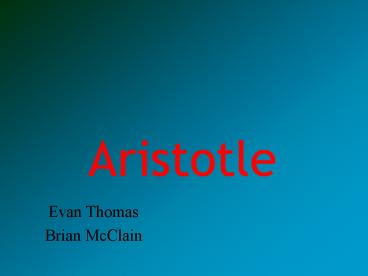Aristotle - PowerPoint PPT Presentation
1 / 13
Title:
Aristotle
Description:
Aristotle's best known philosophical theory is that ideal forms or ideas, such ... A geocentric(literally meaning-earth center) was developed by Aristotle thinking ... – PowerPoint PPT presentation
Number of Views:84
Avg rating:3.0/5.0
Title: Aristotle
1
Aristotle
- Evan Thomas
- Brian McClain
2
Aristotle's view on elements
- Aristotle's best known philosophical theory is
that ideal forms or ideas, such as truth or good
are made up and not in the material world. - A geocentric(literally meaning-earth center) was
developed by Aristotle thinking that our earth is
the center of the universe
3
Aristotle's view on elements
- According to Aristotle, the "golden mean" is the
desirable middle ground between any two extremes.
4
(Shows how the elements and their qualities are
arranged and related)
5
Aristotle's diagram
- All substances were combinations of elements and
qualities. The elements are fire, water, earth,
and air. - Aristotle added later another "element" - Ether
which was a perfect substance an what the
heavenly bodies are composed of - The qualities are hot, cold, wet, dry.
6
Democritus
7
Democritus
- The concept of the smallest particle was
developed in the 5th centruy BC by Leucippus.
Democritus developed five major points that their
theory was based upon. Historians have discovered
this from the quotes of other Greeks (most of the
original documents by Leucippus and Democritus
have been lost). In the 4th centruy BC, the well
known philosopher Aristotle argued that the
atomic theory was completely incorrect and was
dismissed by scientists for many decades.
8
5 points by Democritus
- Point 1 - All matter is made up of undividable
particles called atoms. - Point 2 - There is a void, which is empty space
between atoms. - Point 3 - Atoms are completely solid.
- Point 4 - Atoms are homogeneous, with no
internal structure.
9
- Point 5 - Atoms vary in 1) Size 2) Shape. 3)
Weight
10
Dalton
- It was in the early 1800s that John Dalton, an
observer of weather and discoverer of color
blindness among other things, came up with his
atomic theory.
11
Daltons Findings
- In 1803 Dalton noted that oxygen and carbon
combined to make two compounds. Of course, each
had its own weight ratio of oxygen to carbon
(1.331 and 2.661), but also, for the same
amount of carbon, one had exactly twice as much
oxygen as the other
12
Daltons Findings
- This led him to propose the Law of Simple
Multiple Proportions, which was later verified by
the Swedish chemist Berzelius. In an attempt to
explain how and why elements would combine with
one another in fixed ratios and sometimes also in
multiples of those ratios, Dalton formulated his
atomic theory.
13
Daltons Model
- Dalton's model was that the atoms were tiny,
indivisible, indestructible particles and that
each one had a certain mass, size, and chemical
behavior that was determined by what kind of
element they were.































